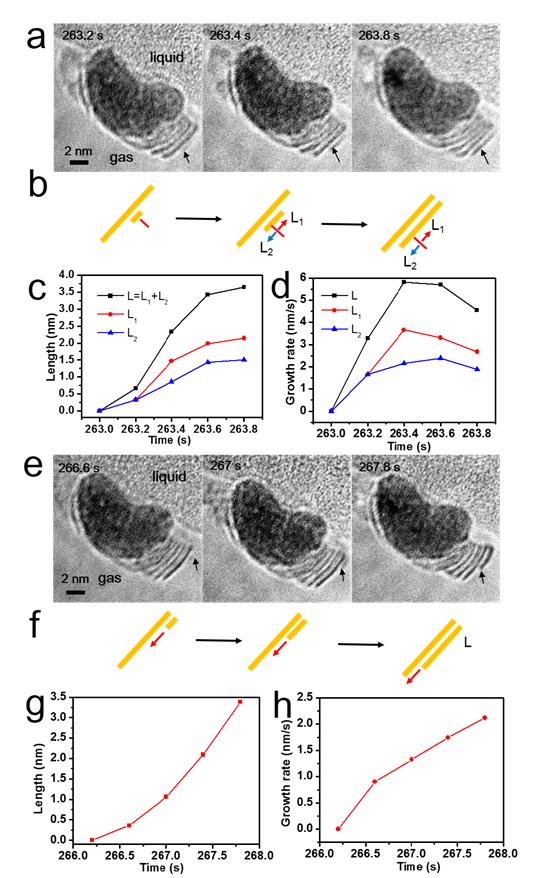Tracking the atomic pathways by in-situ liquid cell TEM

(a, e) Time-lapse sequence of TEM images showing the nucleation growth process of single layer Ni(OH)2 in the Pt3Ni-Ni(OH)2 core-shell structure extracted from movie. (b, f) Schematic illustrations of the growth process of Ni(OH)2 single layer in (a, e). The corresponding statistics of the length of growth layer in (a, e) as a function of time (c, g), and statistics of growth rate in (a, e) as a function of time (d, h), respectively. Credit: ©Science China Press
But the detailed formation mechanisms of core-shell structures in solution, especially, at gas-liquid interface are still not completely clear, which is mostly achieved based on post reaction studies or ex situ characterizations.
In this regard, it is worthwhile but still very challenging to directly visualize the complicate and delicate dynamic processes.
Technical advantages of in-situ liquid electron microscopy (TEM) allow us to monitor the growth trajectory of pure metal nanoparticles in liquid media, including nucleation growth, nanorod self-assembly, and electrochemical deposition.
Compared with pure metal nanocrystals, the growth pathway for alloy and its oxide core-shell structures is more complicated.
It is noteworthy that little is known about the atomic growth pathway of Pt based-oxide core-shell structures and structural stability in solution, especially, at the gas-liquid interface. Due to the lack of direct observation method with high spatial resolution, some intermediate states may be easily missed.
Herein, Honggang Liao's group first observed the atomic growth way of Pt3Ni-Ni(OH)2 core-shell structure at gas-liquid interface using in-situ liquid cell TEM.
Experiment results revealed the underlying growth and transformation mechanisms of the Pt3Ni-Ni(OH)2 core-shell structure by systematically changing the Ni:Pt ratio in the precursor solution and tuning electron beam dose rate.
Key questions regarding the growth mechanism for single- and multi-layer Ni(OH)2 flakes were addressed. It is anticipated that this work could provide atomic insights on the rational design of metal-2D core-shell structures for potential wide range applications.
###
This work was supported by the National Key Research and Development Program of China (2017YFA0206500) and the National Natural Science Foundation of China (21673198, 21373008, 21621091).
See the article: Zhang J, Li G, Liao HG, Sun SG. Tracking the atomic pathways of Pt3Ni-Ni(OH)2 core-shell structures at the gas-liquid interface by in-situ liquid cell TEM. Sci China Chem, 2020, 63, 513-518. https:/
Media Contact
More Information:
http://dx.doi.org/10.1007/s11426-019-9663-8All latest news from the category: Life Sciences and Chemistry
Articles and reports from the Life Sciences and chemistry area deal with applied and basic research into modern biology, chemistry and human medicine.
Valuable information can be found on a range of life sciences fields including bacteriology, biochemistry, bionics, bioinformatics, biophysics, biotechnology, genetics, geobotany, human biology, marine biology, microbiology, molecular biology, cellular biology, zoology, bioinorganic chemistry, microchemistry and environmental chemistry.
Newest articles

A universal framework for spatial biology
SpatialData is a freely accessible tool to unify and integrate data from different omics technologies accounting for spatial information, which can provide holistic insights into health and disease. Biological processes…

How complex biological processes arise
A $20 million grant from the U.S. National Science Foundation (NSF) will support the establishment and operation of the National Synthesis Center for Emergence in the Molecular and Cellular Sciences (NCEMS) at…

Airborne single-photon lidar system achieves high-resolution 3D imaging
Compact, low-power system opens doors for photon-efficient drone and satellite-based environmental monitoring and mapping. Researchers have developed a compact and lightweight single-photon airborne lidar system that can acquire high-resolution 3D…





















